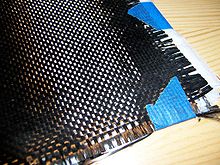Mechanical engineers are constantly pushing the boundaries of what is physically possible in order to produce safer, cheaper, and more efficient machines and mechanical systems. Some technologies at the cutting edge of mechanical engineering are listed below (see also exploratory engineering).
Micro electro-mechanical systems (MEMS)
Micron-scale mechanical components such as springs, gears, fluidic and heat transfer devices are fabricated from a variety of substrate materials such as silicon, glass and polymers like SU8. Examples of MEMS components are the accelerometers that are used as car airbag sensors, modern cell phones, gyroscopes for precise positioning and microfluidic devices used in biomedical applications.
Friction stir welding (FSW)
Main article: Friction stir welding
Friction stir welding, a new type of welding, was discovered in 1991 by The Welding Institute (TWI). The innovative steady state (non-fusion) welding technique joins materials previously un-weldable, including several aluminum alloys. It plays an important role in the future construction of airplanes, potentially replacing rivets. Current uses of this technology to date include welding the seams of the aluminum main Space Shuttle external tank, Orion Crew Vehicle test article, Boeing Delta II and Delta IV Expendable Launch Vehicles and the SpaceX Falcon 1 rocket, armor plating for amphibious assault ships, and welding the wings and fuselage panels of the new Eclipse 500 aircraft from Eclipse Aviation among an increasingly growing pool of uses.[30][31][32]
Composites
Main article: Composite material
Composites or composite materials are a combination of materials which provide different physical characteristics than either material separately. Composite material research within mechanical engineering typically focuses on designing (and, subsequently, finding applications for) stronger or more rigid materials while attempting to reduce weight, susceptibility to corrosion, and other undesirable factors. Carbon fiber reinforced composites, for instance, have been used in such diverse applications as spacecraft and fishing rods.
Mechatronics
Main article: Mechatronics
Mechatronics is the synergistic combination of mechanical engineering, electronic engineering, and software engineering. The purpose of this interdisciplinary engineering field is the study of automation from an engineering perspective and serves the purposes of controlling advanced hybrid systems.
Nanotechnology
Main article: Nanotechnology
At the smallest scales, mechanical engineering becomes nanotechnology—one speculative goal of which is to create a molecular assembler to build molecules and materials via mechanosynthesis. For now that goal remains within exploratory engineering. Areas of current mechanical engineering research in nanotechnology include nanofilters,[33] nanofilms,[34] and nanostructures,[35] among others.
See also: Picotechnology
Finite element analysis
Main article: Finite element analysis
This field is not new, as the basis of Finite Element Analysis (FEA) or Finite Element Method (FEM) dates back to 1941. But the evolution of computers has made FEA/FEM a viable option for analysis of structural problems. Many commercial codes such as ANSYS, NASTRAN, and ABAQUS are widely used in industry for research and the design of components. Some 3D modeling and CAD software packages have added FEA modules. In the recent times, cloud simulation platforms like SimScale are becoming more common.
Other techniques such as finite difference method (FDM) and finite-volume method (FVM) are employed to solve problems relating heat and mass transfer, fluid flows, fluid surface interaction, etc. In recent years meshfree methods like Nogrid points become more popular in case of solving problems involving complex geometries, free surfaces, moving boundaries, and adaptive refinement.
Biomechanics
Main article: Biomechanics
Biomechanics is the application of mechanical principles to biological systems, such as humans, animals, plants, organs, and cells.[36] Biomechanics also aids in creating prosthetic limbs and artificial organs for humans.
Biomechanics is closely related to engineering, because it often uses traditional engineering sciences to analyse biological systems. Some simple applications of Newtonian mechanics and/or materials sciences can supply correct approximations to the mechanics of many biological systems.
Over the past decade the Finite element method (FEM) has also entered the Biomedical sector highlighting further engineering aspects of Biomechanics. FEM has since then established itself as an alternative to in vivo surgical assessment and gained the wide acceptance of academia. The main advantage of Computational Biomechanics lies in its ability to determine the endo-anatomical response of an anatomy, without being subject to ethical restrictions.[37] This has led FE modelling to the point of becoming ubiquitous in several fields of Biomechanics while several projects have even adopted an open source philosophy (e.g. BioSpine).
Computational fluid dynamics
Main article: Computational fluid dynamics
Computational fluid dynamics, usually abbreviated as CFD, is a branch of fluid mechanics that uses numerical methods and algorithms to solve and analyze problems that involve fluid flows. Computers are used to perform the calculations required to simulate the interaction of liquids and gases with surfaces defined by boundary conditions. With high-speed supercomputers, better solutions can be achieved. Ongoing research yields software that improves the accuracy and speed of complex simulation scenarios such as transonic or turbulent flows. Initial validation of such software is performed using a wind tunnel with the final validation coming in full-scale testing, e.g. flight tests.
Acoustical engineering
Main article: Acoustical engineering
Acoustical engineering is one of many other sub disciplines of mechanical engineering and is the application of acoustics. Acoustical engineering is the study of Sound and Vibration. These engineers work effectively to reduce noise pollution in mechanical devices and in buildings by soundproofing or removing sources of unwanted noise. The study of acoustics can range from designing a more efficient hearing aid, microphone, headphone, or recording studio to enhancing the sound quality of an orchestra hall. Acoustical engineering also deals with the vibration of different mechanical systems.[


No comments:
Post a Comment